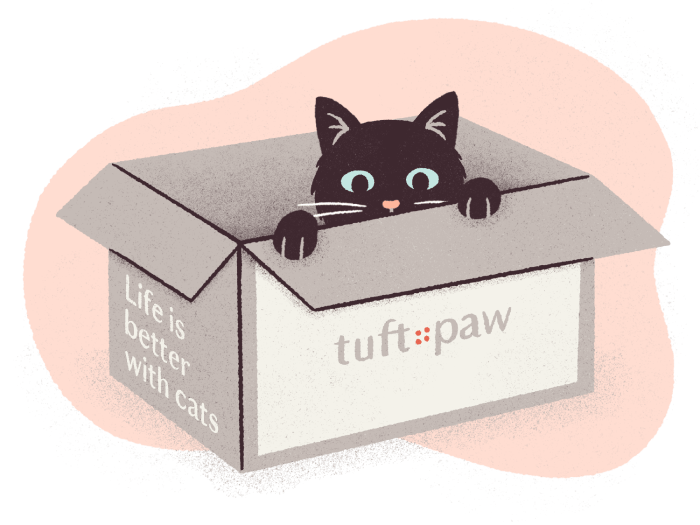Clay cat litter is the most widely used kind of cat litter, but is it the best? In recent years, many parents have switched to other types of litter for a number of reasons, including dust, tracking, health concerns, and the environmental cost of clay mining. In this article, we’ll go over the pros and cons of clay cat litter to help you decide if its the best option for you and your cat.
Here at tuft + paw, we are cat experts. Over the last couple years, we've spent countless hours determining which litter features are most important to cats and cat parents alike. The information in this article is based on consultation with a cat behaviorist and veterinarian, hundreds of customer reviews, and our own experience as cat parents.
What is Clay Cat Litter?
Clay cat litter is one of the oldest and most traditional types of litter used by cat owners worldwide. It was first introduced in 1947 and has since become a staple in the pet care industry. Clay litter is known for its affordability, strong clumping abilities, and widespread availability in pet stores and supermarkets. Its texture, resembling natural soil, often appeals to cats, making it a popular choice for many cat parents.
Pros of Clay Cat Litter
Affordable
One of the biggest advantages of clay cat litter is its affordability. The clay mining industry existed well before clay was used in litter boxes, so clay cat litter benefits from this preexisting supply chain and the huge scale of clay mining. It’s easily the most affordable type of clumping litter, and one of the most affordable non-clumping options along with generic wood pellets.
Strong Clumping
Clay litter forms very firm clumps when it comes into contact with moisture, making it easy to scoop out soiled litter and maintain a clean litter box. This clumping action helps to lock in odors, keeping your home smelling fresh.
Widely Available
Clay cat litter is readily available in various brands and formulations, making it convenient for cat owners to find and purchase at their local pet stores or online retailers.
Paw-Friendly Texture
The texture of clay litter closely resembles natural soil or sand, which many cats find comfortable to dig in and bury their waste. This familiarity can encourage cats to use the litter box consistently.
Cons of Clay Cat Litter
Crystalline Silica Dust
One of the major drawbacks of clay cat litter is the presence of crystalline silica dust, which poses health risks to both cats and humans when inhaled. According to the CDC, silica dust is a known carcinogen when inhaled and can cause respiratory issues in cats and humans. In industrial settings, workers that encounter silica dust usually wear respirators and take extensive precautions to avoid these problems. To make matters worse, clay cat litter is known for being particularly dusty, especially when pouring into the litter box.
Sourced by Strip Mining
Clay litter is sourced through strip mining, an environmentally damaging practice that involves removing the top layer of earth to access mineral deposits underneath. This process results in habitat destruction, water pollution, and soil erosion, contributing to environmental degradation.
Not Biodegradable
Unlike many natural alternatives, clay cat litter is non-biodegradable, meaning it does not break down easily in landfills and contributes to waste accumulation over time.
Prone to Tracking
Clay litter particles are often very small and dusty, making them prone to tracking outside of the litter box and scattering throughout the home. This can result in messes and require frequent cleaning to maintain cleanliness. There are many non-tracking cat litters out there, but unfortunately none of them are made from clay.
Very Heavy
Clay litter is considerably heavier than many alternative lightweight litter options, making it cumbersome to transport and handle, especially for individuals with mobility issues or limited strength.
Dangerous If Ingested
Another concern with clay litter is the risk of ingestion, particularly for curious cats or kittens. Ingesting clay litter can lead to gastrointestinal blockages or digestive issues, especially if the litter forms hard clumps in the cat's digestive tract.
Clay Cat Litter Alternatives
Tofu Cat Litter
Made from natural tofu residue, tofu cat litter is biodegradable, lightweight, and dust-free. It forms solid clumps for easy scooping and disposal, offering an eco-friendly alternative to traditional clay litter.
Best Tofu Litter: tuft + paw Really Great Cat Litter
Crystal (Silica) Cat Litter
Crystal cat litter consists of silica gel beads that absorb moisture and trap odors effectively. It's low-dust, lightweight, and easy to clean, making it a tidier option for both cats and cat parents.
Best Crystal Litter: Pretty Litter
Wood Pellet Cat Litter
Made from compressed wood fibers, wood pellet cat litter is highly absorbent and biodegradable. It has a natural scent and texture that many cats find appealing, and it's gentle on sensitive paws.
Best Wood Pellet Litter: Feline Pine Platinum
Other Natural Cat Litters
There are various other natural cat litter options available, including those made from recycled paper, corn, wheat, or grass. These litters are typically biodegradable, eco-friendly, and free from harmful additives or chemicals.
Conclusion: Your Cat Knows Best
While clay cat litter offers affordability and strong clumping, it also comes with potential health and environmental risks. Exploring alternative litter options, such as tofu, crystal, or wood pellet litter, can provide a safer and more sustainable solution for you and your cat. Ultimately, the best litter choice is one that meets your cat's preferences and needs while prioritizing their health and well-being.





